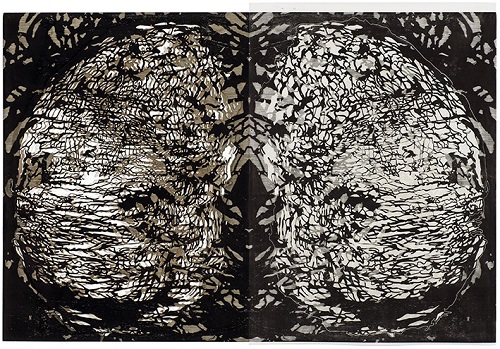Summary |
This project aims to acknowledge the complexity within place relationships that bear witness to the imprint of settler colonialism |
|---|---|
Start Date |
July 6, 2018 12:00 pm |
End Date |
July 12, 2018 5:00 pm |
Venue |
Plimsoll Gallery |
Walking contested ground: navigating settler colonial place through drawing and printmaking.

Image credit: Antonia Aitken, Untitled II (holdfast iterations), 2018, hand and lasercut plywood and woodcut print on mulberry paper, 120 x 180cm
Opening event: Fri 6 July, 5.30 – 7.00 pm
Exhibition dates: Sat 7 July – Thurs 12 July, 2018
Gallery Hours: Wed - Sun 12pm - 5pm (during exhibitions)
Closed Mondays, Tuesdays and Public holidays
Abstract:
This project considers how the slow, rhythmic and repetitive movements inherent in the embodied actions of walking, printmaking and drawing generate sensitive responses to place. This project aims to acknowledge the complexity within place relationships that bear witness to the imprint of settler colonialism. The project addresses the growing need to consider how we come to terms with the discomfort of contradictory sets of experiences that are part of walking in contested lands.
Walking enables a slowed-down and embodied attentiveness to navigate relationships with place. Perceptions of linear time dissolve to reveal a complex merging and co-mingling of observations, memories and imaginings. This methodology develops a sense of a simultaneously moving internal and external passage; an entangled or knotted-time which is reflected in the conceptual, visual and material explorations within this project.
lutruwita (Tasmania) is a place with vibrant and resistant Aboriginal culture, despite the ongoing impacts of settler colonialism. It has a strong and diverse community made up of interconnected narratives; people who are finding and testing new ways to voice the stories of this place. I relocated from Canberra to Hobart in 2014 to undertake this project and I began my relationship by enacting a daily ritual of stepping out my front door and into relation with my immediate environment. Over four years I have walked a web of connection between my place of dwelling and a number of key locations in and around the Hobart region.
Informed by a material knowledge of printmaking and drawing, and expanded through 3D fabrication technologies, sound and video, the studio research has engaged an iterative making process mirroring the repetitive looping motions and the entangling of thought embedded in the walking body. Two forms emerged as central to the work during the early stages of the project - the holdfast, from the Giant Kelp (Macrocystis pyrifera) found on Bruny Island, and a series of stick shelters encountered in Knocklofty Reserve on the flanks of kunanyi / Mount Wellington. Gaston Bachelard’s notion of the image cluster has been used in relation to these two forms which communicate my shifting feelings of entanglement, attachment and dislodgement.
This research is situated within the interdisciplinary fields of walking based practice and critical place inquiry. Led by place philosophers, indigenous scholars, artists and sociologists, research and pedagogies from these fields reemphasise the importance of embodied knowledge, notions of motility, porosity and heterogeneity in our conceptualisations of place. These ideas counter dominant colonising ideas of fixity, impermeable boundaries and monologue.
Arriving in Hobart to undertake the project I was met by an unfamiliar sense of place panic, described by philosopher Edward. S Caseyas a common feeling of estrangement or displacement when separated from one place and experiencing a new and unfamiliar place. This experience directed the project towards a deeper investigation of philosophical concepts of place, home-place attachment, and desires for lost intimacy with land. This discussion has been supported by the writings of contemporary Australian philosopher Val Plumwood, writer Ross Gibson, and anthropologist Deborah Bird-Rose. By investigating of the work of artists Marlene Creates, Richard Long, James Tylor, Simryn Gill and Julie Gough, the project further explores the ways in which our personal and cultural desires, losses and longings inherently shape our conceptualisations of and relationships with place.
Within the field of walking based practice, my work contributes to the linkage between settler colonial places and the use of walking methodologies to support the development of dialogical relations. Whilst acknowledging that walking is not exempt from contestation, this project presents new knowledge in regards to these ideas and the use of walking based practice through the development of strategies and approaches to navigating concerns around trespass and invasion. This methodology opens up a form of embodied and relational dialogue that leads to meaningful ongoing relationships with place, including important intercultural connections. The research outcomes contribute to decolonising modes of practice by developing an ethical relationship and methodology for approaching contested ground as a settler Australian artist through process. The research proposes that such approaches and practices are critically needed and central to acknowledging the complex histories that lie within our land.